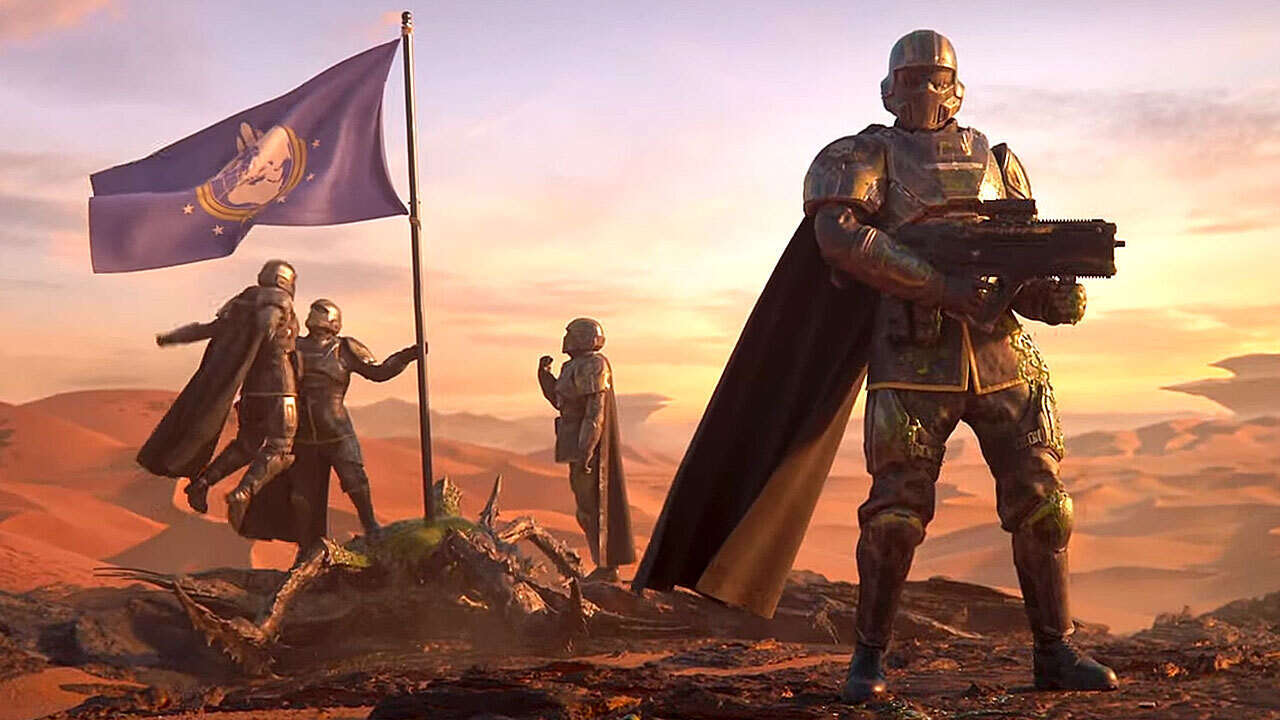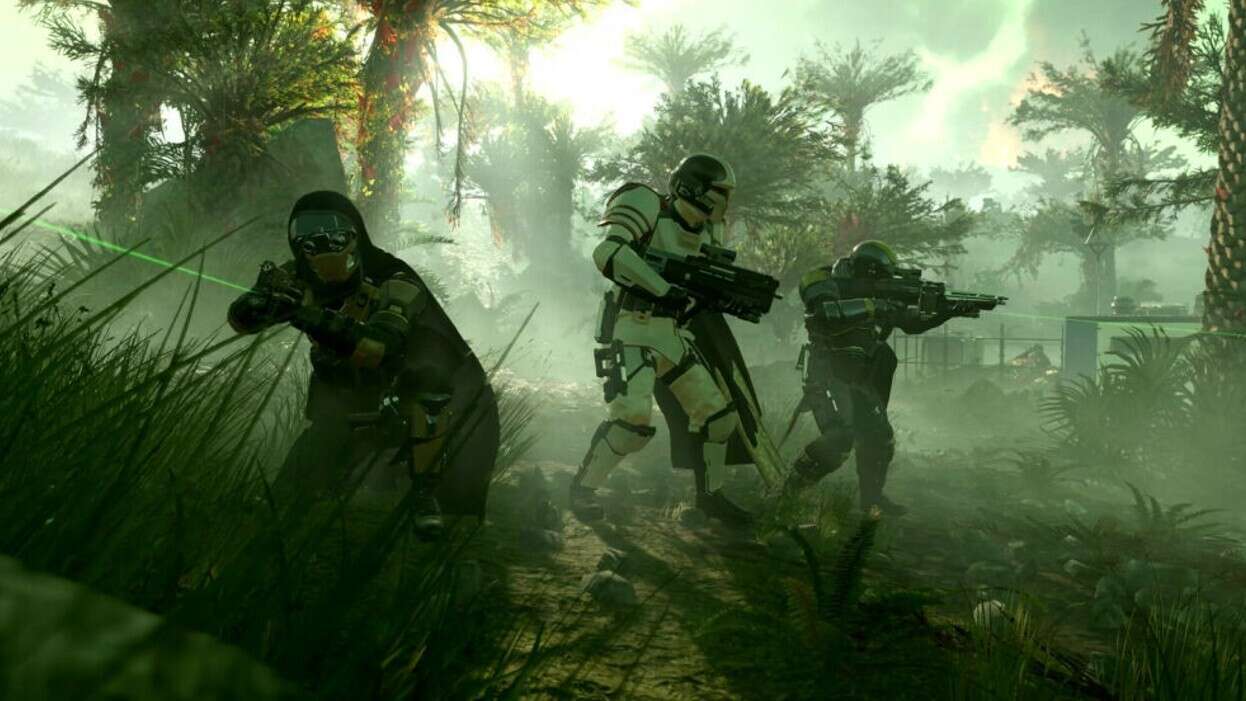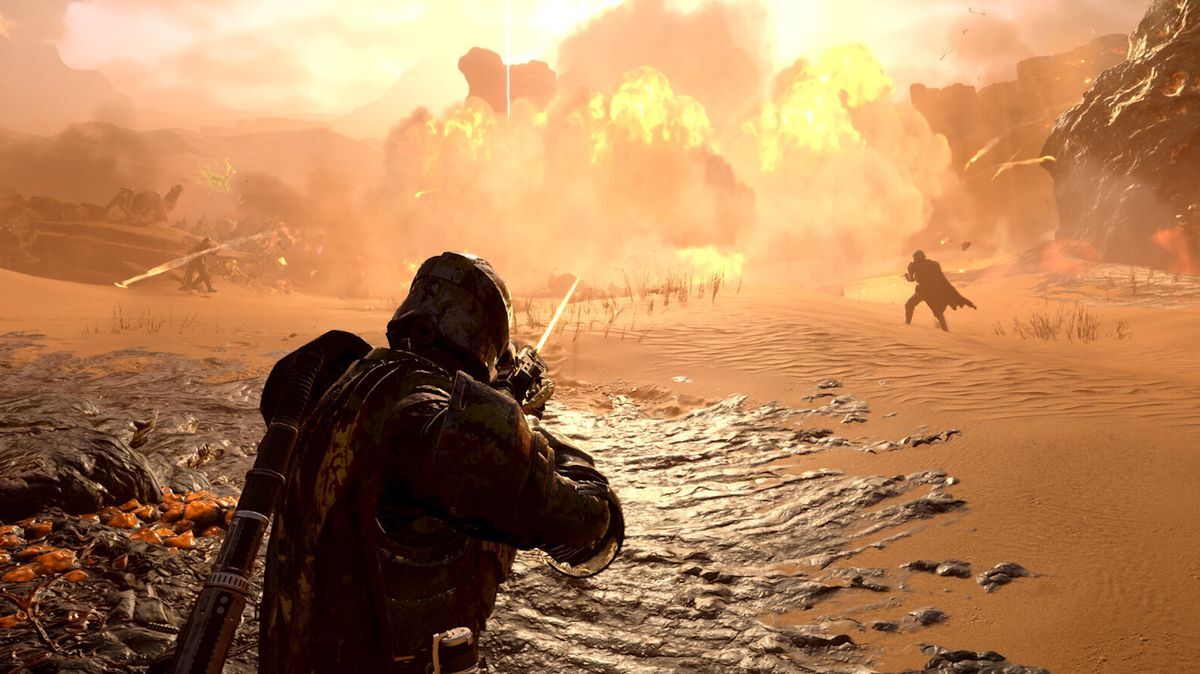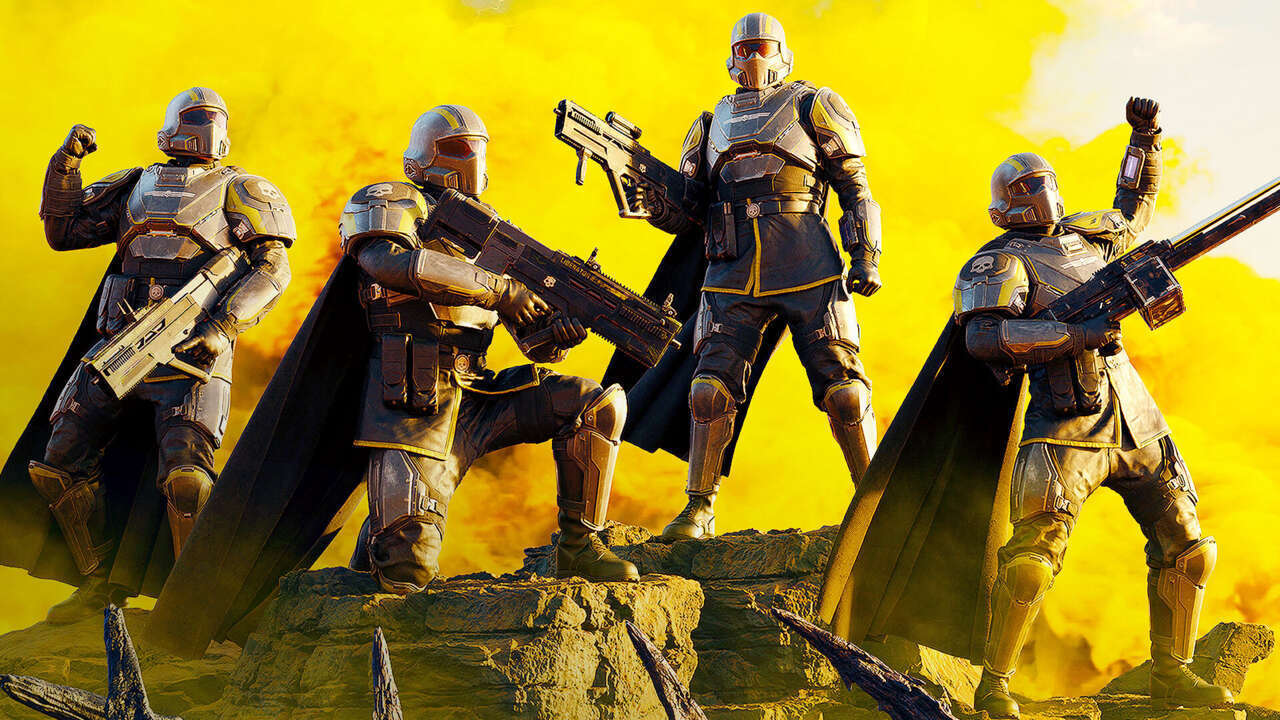It’s a bold swing to dramatically change a formula that you know is working, but the gamble has paid off for Arrowhead Game Studios. Helldivers 2 opts for an over-the-shoulder third-person perspective as opposed to the original game’s top-down view, making for a shooter that pulls you closer into the thick of its frenetic combat. This shift brings Helldivers 2’s gameplay better in line with its ludicrous narrative tone, managing to create memorably explosive firefights despite the repetitive enemy types and map designs. Helldivers 2 is an incredible game–it sets out to be a rambunctious and entertaining shooter and hits that target with military precision.
Helldivers 2 sees you step into the patriotic boots of the titular fighting force, lowly grunts on the frontlines of an intergalactic war in defense of Super Earth. Missions take place on randomly generated planets, ranging from ice-covered tundras to lush jungles. You and your squad have a set amount of time to complete your main objective and any optional assignments, needing to successfully extract to bring any collected goodies back with you. Though you’re armed with the usual weapons of war found in shooters (primary and secondary weapons, grenades, and healing syringes), your main means of dealing big damage and supporting your squad are the stratagems you can call in, such as powerful machine guns or explosive air strikes.
Stratagems make you a juggernaut of destruction, allowing you to call in absurdly powerful weapons to devastate anything in your path. Having the right one on hand can save a mission, but Helldivers 2 never punishes you for what you choose to bring into a fight–if you have a favorite, chances are it will always be useful in some capacity. They never make the game too easy, either–limited uses and timers restrict just how often you can call in the big guns, encouraging you to rely on your allies while you wait for your stratagems to recharge. Plus, there are a lot of enemies to fight in each mission, swarming you at a moment’s notice. Calling in an airstrike and getting a 15-enemy kill streak feels amazing, but it doesn’t change that once it’s over there could still be another 20 enemies to clean up. The stratagems only get you so far–at some point, you have to get good at shooting with the normal weapons too, incentivizing you to improve and not just rely on a series of explosive hardware.
The stratagems are delightfully varied in terms of what they bring to the table, though it’s primarily all through the lens of blowing stuff up in different ways. There are a few outliers–the jetpack and energy dome shield are notable examples–but most stratagems boil down to hurting enemies. This isn’t inherently bad, but it is a little limiting for players who want to take on more supportive roles in the makeup of their squad. As a live-service game, these types of stratagems could be coming in a future update. For now, however, the make-up of the stratagems ensures each mission is typically only won by delivering the most pain as quickly as possible.
To its credit, Helldivers 2 leans into this notion, with a humorous narrative tone reminiscent of Starship Troopers. Death is a cheap and common occurrence–friendly fire is always on and Helldivers 2’s assortment of robotic and giant bug enemies don’t mess around. The general vibe of each mission is that you’re expected to die a lot and that giving your life for the glory of Super Earth is something to be proud of. With that being the case, why would you offer the player many tools by which they could potentially shield an ally, redirect a threat, or better escape a bad situation? I don’t necessarily disagree with that notion, but I still can’t stop myself from wishing Helldivers 2 had more opportunities to help preserve and protect the lives of my fellow soldiers, especially on the harder difficulties where each Helldivers’ life suddenly becomes quite valuable. It’s a little frustrating trying to stay alive on the game’s toughest difficulties when there’s not much in the game that helps you do that.

Humor is Helldivers 2’s strongest asset. The jokes sprinkled into the narrative elements are hit-or-miss, but the very nature of how dangerous you are to your allies creates some of the most hilarious moments I’ve ever had in a shooter. Whether it’s an ally accidentally stepping into the path of a stray sniper bullet, one teammate purposively sacrificing another by tossing a beacon on their position to call in an air strike to blow up the encroaching enemy horde, or a turret mistakenly marking a teammate for violent deletion, every session I’ve had of playing Helldivers 2 has left me wheezing with laughter. And, of course, the tears in my eyes inevitably distract me long enough that I do something stupid, leading to me or my teammate dying in another hilarious display of explosive carnage. The non-stop slapstick humor is often punctuated by the Helldivers screaming that it’s all in the name of democracy or that the enemy is about to get an explosive sip of “liber-tea.” It’s so stupid. And yet it’s the ridiculousness of the whole thing that makes it all the more hilarious–even friendly fire, a usually infuriating feature in other shooters–is reduced to an absurd joke in Helldivers 2, as you can easily call an ally back in as an equally disposable soldier. Just be careful not to get crushed by the drop pod delivering your backup.
Shooting in Helldivers 2 feels great, too. Even if you can’t always stay alive, at least you’ll go out satisfyingly blasting enemies into puddles. Assault rifles and submachine guns puncture enemies in gooey explosions, shotguns carve through armor with lethal thumps, and sniper rifles slice through targets with lethal precision. Every weapon in Helldivers 2 feels suitably dangerous to fire, and an assortment of enemy resistances balances things out to keep any one firearm from feeling frustratingly useless or boringly overpowered–everything has a purpose, and it accomplishes that purpose well. There’s simultaneously a sense of satisfaction to mulling over your ideal loadout, and comfort in knowing there’s no real wrong answer to what you pick, provided you don’t outfit yourself with a bunch of weapons and stratagems that are all geared toward addressing the same exact problem. And even then, having up to three fellow Helldivers playing with you could account for that shortcoming.

Helldivers 2 is clearly meant to be experienced with communicative allies at your side. Though you can enjoy Helldivers 2 solo, the game is far more enjoyable in co-op, working alongside a team to accomplish more tasks during your limited time. You also earn more rewards for extracting from missions with larger teams and have a greater number of lives within bigger groups. Companions can make certain weapons easier to use as well–a rocket launcher that’s irritatingly slow to reload on its own is made a lot better when an ally picks up the pack of extra rockets and follows you around to load them for you, cutting down the reload time by a significant margin.
This focus on co-op is why I’m bummed about the game’s ping system. It’s not terrible–it gets the job done in most cases, like pointing out enemies or tagging objectives. But it can’t handle more complex forms of communication. As an example: I’ve been on missions with strangers where one Helldiver needed to watch a terminal to communicate to the other players how much they needed to adjust a satellite dish on the other end of the compound. It’s a relatively simple puzzle that’s easily handled via microphone, but none of us were using them, and the shortcomings of the ping system were quite apparent at that moment. Luckily, through a little bit of guesswork and trial and error, our squad was able to brute force the solution–one Helldiver kept moving the satellite dish randomly while another just waited at the terminal to push a button the moment everything happened to align. We were playing on an easier difficulty as well so it wasn’t too tricky for the final two squad members to hold the line while the objective played out. But Helldivers 2 isn’t as forgiving on the tougher difficulties, and you earn extra rewards for completing missions quickly, so it’s irritating to sometimes be held up solely because no one is able to adequately communicate with each other. If there’s going to be a ping system, it should account for every objective type you encounter in the game.
Speaking of, Helldivers 2 has a good assortment of mission variety. On their own, each aspect of missions feels a little samey. The assortment of murderous bugs and clanking robots begins to bleed together as a monotonous evil force (especially the bugs–there’s more enemy variety on the robot front). There also isn’t much randomization to the topography of the environments to make each planet feel drastically different, and there are only a dozen or so objectives and sub-objectives in the game. But Helldivers 2 does a terrific job of randomizing all of these elements just enough to make missions feel mostly distinct. Two back-to-back missions might task you with tracking down launch codes and then successfully firing a rocket, for instance, but the first may be on an icy planet that affects how long equipment overheats and sees you contending with armor-plated robots on the way to the objective while the latter may be in a fog-filled jungle that greatly lowers visibility and surrounds you with flammable foliage, making it trickier to use fire against the very flammable bugs stalking your path. At a glance, you’re just doing the same objective over again. But these small adjustments to the mission parameters culminate in both playing out quite differently.
Helldivers 2 is just a really good time, and it banks on that being enough to convince you to stick around for a long time.
To that end, Helldivers 2 accomplishes the day-one dream for a live-service game: You want to keep playing it. Missions aren’t exactly quick–the shortest takes about 10 minutes while the longest is closer to 40–but they don’t feel like a slog because they aren’t cookie-cutter copies of each other. Plus, there’s such a thrill at pulling off a successful assignment and seeing your deeds add up to enough points to buy a new upgrade or firearm or piece of armor. And then, if you’re like me, you immediately want to jump into another mission to try out the new goodie, only to do well enough to potentially unlock something else. Helldivers 2 isn’t stingy with the unlocks, letting you quickly start nabbing new airstrikes, turrets, guns, grenades, and silly victory poses.
Though there is a premium reward track and in-game store, there’s plenty of good stuff in the standard free track. Completing missions nets you Medals that you can spend on new weapons, armor, poses, and banners in both the free and premium reward tracks, as well as Requisition Slips for new stratagems. Meanwhile, the items in the store take Super Credits–this currency can occasionally be randomly found in missions but is more easily obtained by either dropping real money or spending Medals in both the free and premium reward tracks. Finally, there are Samples, a currency that is exclusively found in missions, often in optional locations off the beaten path. You can spend these to unlock permanent upgrades, like granting quicker cooldown times on certain stratagems.
This is too many in-game currencies spread out over too many in-game menus making it all too easy to lose track of what unlocks what. However, it’s great that all of these currencies are at least set up so that everything in Helldivers 2 can be unlocked simply by playing the game–even the premium reward track is unlocked with Super Credits, meaning you can earn it without having to drop a dime. There’s no time limit on Helldivers 2’s reward tracks either as Arrowhead has said each one will stick around forever. This decision graciously lessens the pressure to stay on the grind day-to-day or drop more money.
Using just the free track, I managed to unlock three new firearms, a new grenade, and a new victory pose within the first few hours of play. So far, my progress has been pretty consistent. Every time you complete a mission at a certain difficulty, you unlock the next level, and each subsequent level carries the promise of greater rewards, allowing you to maintain the speed at which you’re unlocking new equipment. And when you begin to hit a lull, that’s usually a good indicator that you’ve unlocked and played enough that it’s time to move on to the next difficulty level. Presumably, I’ll hit a skill ceiling eventually that stalls how quickly I can unlock Helldivers 2’s late-level weapons and armor but it hasn’t happened yet. In the meantime, I’m going to keep enjoying the game.


The only aspect of Helldivers 2 I’m still unsure about is the Game Master, the force responsible for reacting to how people are playing to make certain objectives harder or easier, adjust the strategies of enemies, and curate the overarching war effort. As advertised, this is done by members of the Arrowhead team secretly monitoring missions and doing their best to respond to the data they’re receiving–acting similarly to a Game Master of a tabletop game running a combat encounter. Eventually, the Game Master will even direct the narrative direction of Helldivers 2, responding to how well the community bands together to dictate how the war effort progresses. Helldivers 2 has only been out for a week as I’m writing this review, so there hasn’t been much time to see how the Game Master feature will work–I assume that larger, more easily identifiable adjustments will take time to implement and anything the game has done for me so far has just been too minor to note. Regardless, it’s just too soon to make a judgment call on whether or not the Game Master feature adds anything meaningful to the experience of playing the game.
In the ever-crowded live-service shooter landscape, Helldivers 2 manages to carve out a place for itself with its fun narrative tone, punchy combat, intense firefights, and rewarding progression track. Helldivers 2 has plenty of tense moments against gargantuan bugs and hulking tank-like machines, but the entire experience is largely meant to make you feel good and have a laugh with friends, a refreshing notion for how darkly serious most major shooters are today. This provides Helldivers 2 with a sensation of potential longevity and lasting power I haven’t felt from most new live-service games in recent years. Helldivers 2 is just a really good time, and it banks on that being enough to convince you to stick around for a long time. Frankly, I’m sold–it’s the most fun I’ve had in a new shooter in years.

